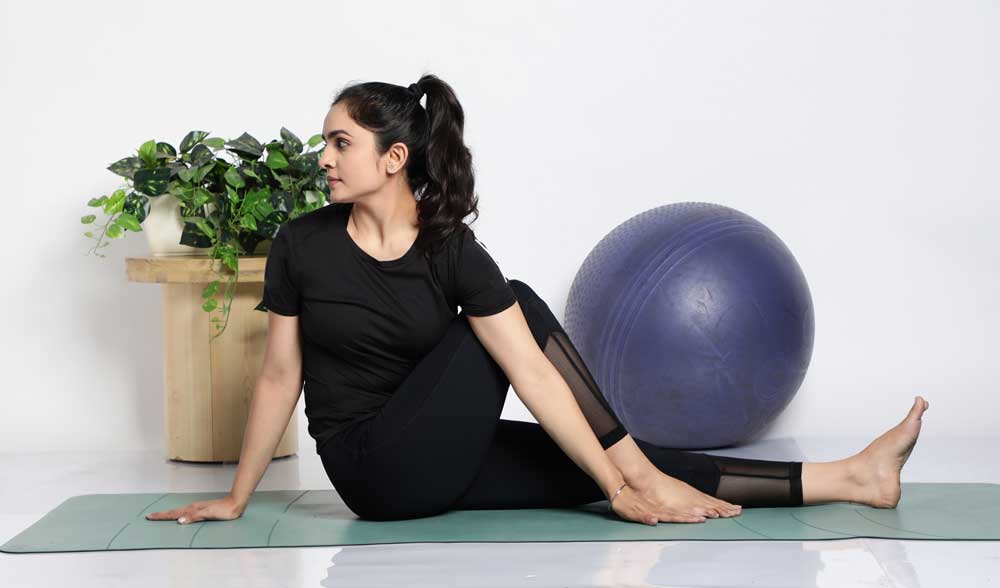Imagine a workout that is entirely self-led, with benefits for both body and brain. Celebrities like Kate Hudson and Reese Witherspoon have jumped onto the Gentle Somatic Yoga bandwagon, and for good reason. Although the concept of somatic yoga has been around for nearly half a century, the practice has only gained momentum in the last few years, as the importance of mindfulness in movement has been highlighted by wellness experts. But what exactly is somatic yoga?
Says yoga instructor Harsha Karthik, ‘Somatic means relating to a person's ‘soma’ or physical aspects. The word soma means body in ancient Greek. Traditional yoga originated roughly 5,000 years ago in ancient India and combines physical and spiritual practices. Although there are several streams of yoga, the core values and purpose have remained the same over centuries. However, somatic yoga veers away from these ideas very slightly. When you combine yogic practices with physical self-awareness, it is called somatic yoga. Somatic yoga is a modern-day global phenomenon that focuses primarily on understanding your body and listening to it while conducting your practice. So, you must be self-aware. A yoga instructor can guide you and offer you training, but you also have to be intuitive enough to understand what’s working for you. Your practice is based on the body you perceive from within, rather than what tradition dictates. This is especially ideal for beginners, who may find it hard to cope with challenging postures at first.’
In the mid-20th century, Moshe Feldenkrais developed somatics as a discipline, pioneering a method of movement called the Feldenkrais Method. This emphasised movement control and awareness as the primary steps to restore the connection with your body, release any built-up tension or stress, and restore effective functions such as agility and motor skills. In the 1970s, Thomas Hanna furthered research with his method Hanna Somatics, which involved the contraction and release of muscles mindfully. He was a forerunner in creating gentle yogic movements or somatic yoga, which strengthen the muscle-to-brain connection, through a technique called ‘pandiculation’. While traditional yoga’s ultimate aim is the integration of the mind, body and spirit, somatic yoga prioritises physical well-being and mastery over the body’s functioning and recovery.

Benefits Of Somatic Yoga
1. Releasing tension stored in your muscles and tissues by focussing and addressing their root causes
2. Improving your body’s mobility and joint flexibility through slow, conscious movements
3. Reducing mental stress, anxiety, and trauma through mindful practices
4. Better coordination, balance, and restoring the body’s natural posture and alignment
5. Providing effective pain management if there is any injury or discomfort, without causing any further damage
6. Creating a better connection between the mind and body, due to the level of awareness involved
7. Enabling better functioning of the nervous system through calming and meditative movements (lowering the chances of Parkinsons and other neurological ailments)
8. Enhances brain plasticity, or the ability of your brain to reorganise how you respond to outer stress
Harsha gives us pointers to incorporate somatic yoga in your life:
- Pay attention to how you move, and how you feel during each of these movements, and what your physical sensations are. This means you may have to move slower than usual in the initial stages of practicing Somatic Yoga.
- Asanas such as the cat and cow, spinal twists, the bridge, pelvic tilts, and downward dog are some examples of traditional yogic asanas that you can start your somatic yoga journey with.
- You can close your eyes during this practice, to shut out external visual stimuli. Let your movements be entirely driven from the inside, and deliberate.
- The myth is that somatic yoga doesn’t challenge your body as much as traditional yoga because it is driven entirely by your comfort. This is not entirely true. With time, you learn to reconnect with your body’s specific needs and limitations and push as much as you can.
- Be consistent. Get in 30 minutes of practice every day, or at least thrice a week to begin with. Soon, you’ll be able to follow a hybrid model that blends traditional yogic techniques and somatic yogic principles.
- Even though somatic yoga is all about your personal connection with your body, that doesn’t mean you should practice it without any training or supervision. Ensure you visit a certified and reputed yoga teacher who will guide you in your journey towards mastering this form.
- With somatic yoga, your initial goals shouldn’t be weight loss or muscle toning. You will definitely see these external outcomes, as you master control over your movement and push the boundaries of what you can do. But remember, the initial goal of somatic yoga is to reconnect with your body!